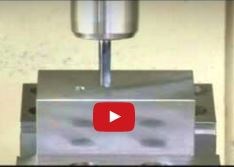Video: Flat-Bottom Drill Versus Conventional
See how a flat-bottom drill tends to shear material as it exists the back side of a workpiece, leaving behind a minimal burr.
Share






Flat-bottom drills are nifty tools. Those that have true 180-degree flat cutting edges can create holes on inclined or curved surfaces without a preliminary center drilling operation to create a start hole. And unlike conventional drills, flat-bottom drills tend to shear material as it exists the back side of a workpiece instead of pushing through, leaving behind a minimal burr.
The video above demonstrates this. Produced by , it shows a slow-motion comparison of a conventional drill and the company’s Aqua Drill Ex Flat completing a through-hole. You can see the tip of the conventional drill pushing through the material, whereas the flat-bottom drill performs more of a shearing operation. The video also shows the flat-bottom drill creating holes in inclined and contoured surfaces without requiring a starter hole.

Related Content
-
Custom Workholding Principles to Live By
Workholding solutions can take on infinite forms and all would be correct to some degree. Follow these tips to help optimize custom workholding solutions.
-
Lean Approach to Automated Machine Tending Delivers Quicker Paths to Success
Almost any shop can automate at least some of its production, even in low-volume, high-mix applications. The key to getting started is finding the simplest solutions that fit your requirements. It helps to work with an automation partner that understands your needs.
-
Quick-Change Tool Heads Reduce Setup on Swiss-Type Turning Centers
This new quick-change tooling system enables shops to get more production from their Swiss turning centers through reduced tool setup time and matches the performance of a solid tool.












